Executive Summary
SG/2010/120
Scottish Government Criminal Justice Directorate
Laid before the Scottish Parliament by the Scottish Ministers
September 2010
ISBN 978 0 7559 9513 4
This document is also available in pdf format (1.1mb)
DPPAS 10415
Contents
Letter to the Scottish Ministers
Chapter 2 Summary of Inspections Undertaken
Chapter 3 Review of the Prison Inspectorate's Year 2009-2010
Previous Reports
1981 - Cmnd 8619
1982 - Cmnd 9035
1983 - Cmnd 9401
1984 - Cmnd 9636
1985 - Cmnd 9909
1986 - Cm 260
1987 - Cm 541
1988 - Cm 725
1989 - Cm 1380
1990 - Cm 1658
1991 - Cm 2072
1992 - Cm 2348
1993 - Cm 2648
1994 - Cm 2938
1995 - Cm 3314
1996 - Cm 3726
1997 - Cm 4032
1998 - Cm 4428 SE/1999/21
1999 - Cm 4824 SE/2000/71
2000 - SE/2001/227
2000 - SE/2000/71
2001 - SE/2001/227
2002 - SE/2002/191
2003 - SE/2003/287
2004 - SE/2004/207
2005 - SE/2005/175
2006 - SE/2006/198
2007 - SE/2007/183
2008 - SE/2008/162
2009 - SG/2009/21
To the Scottish Ministers
I have the honour to submit my first Annual Report to the Scottish Parliament.

HUGH MONRO CBE
HM Chief Inspector of Prisons for Scotland
14 July 2010
1. Overview

Introduction
This is my first Annual Report as Her Majesty's Chief Inspector of Prisons. Like my distinguished predecessor, Dr Andrew McLellan CBE, I have been set a fascinating challenge which I am proud to take on. Andrew McLellan was guided by a strong moral compass in all that he did as Chief Inspector and he adopted a perceptive, compassionate and understanding approach. This is a high standard to follow and I will try my best to do so.
The underpinning strength of the Chief Inspector's role is that of its independent nature. I have been gratified to find that the Cabinet Secretary for Justice, senior politicians whom I have met and Scottish Prison Service and Scottish Government officials, all recognise the importance of this independence.
My first year has been a truly steep learning curve.
I visited all of Scotland's prisons within five weeks of appointment; I have met numerous Government, Local Government and Third Sector organisations;
I have participated in a number of conferences and
I have carried out two inspections in 2009-10. Although I have learned much and formed a number of views, there is yet more to learn and to understand and there are still many questions to be more fully answered.
This Overview sets out my first impressions and the areas of special interest that I have chosen to focus on for the foreseeable future.
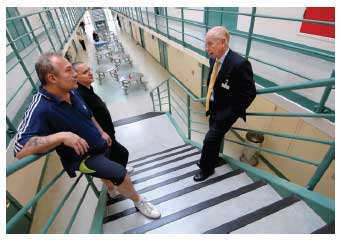
First Impressions
It soon became obvious to me that incarcerating fellow citizens is an awesome responsibility. By and large I have been impressed by Scotland's prisons, both public and private. They are safe and well managed. In many prisons I have seen exceptionally diligent staff looking after prisoners with professionalism and commitment. In many cases specialists such as nurses, psychiatrists, caterers, vocational instructors and teachers also bring excellent standards to bear. There is a lot of best practice across prisons, although this is not always disseminated and shared as well as it might be.
Four of Scotland's largest prisons have been subject to major redevelopment over the last four years and the conditions for prisoners and staff alike have greatly improved on those that my predecessors have inspected. The Inspectorate is therefore able to spend more time examining processes, needs and outcomes than inspecting antiquated prison halls. Commissioning the new HMP Low Moss will be an important addition to the prison estate. Nevertheless, a number of prisons - Barlinnie, Aberdeen, Inverness, Greenock, Dumfries and Peterhead - remain largely unchanged. Peterhead prison's sanitation system is the last remaining from the 'slopping out' era. In 2006 Andrew McLellan reported that the continuation of slopping out in Peterhead prison remained a disgrace and that it was the worst single feature of prisons in Scotland. Steps have been taken to improve the situation since Dr McLellan made his criticism, and the decision to replace HMP Peterhead with a new prison has been announced. Nevertheless, slopping out continues and still presents a significant strategic risk which I will be reporting on in 2010-2011 as part of my formal inspection of Peterhead.
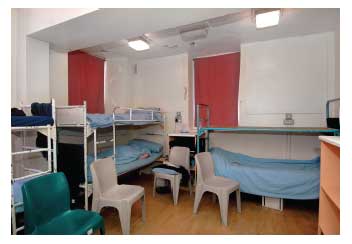
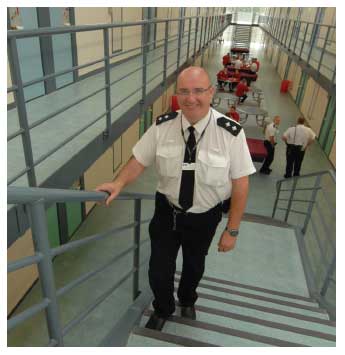
There is still much to be addressed. I worry about the high rates of positive drug testing that point to the smuggling of illegal drugs into prisons and the abuse of prescribed medication. Food is normally of a good standard when cooked in central kitchens but usually deteriorates in terms of temperature and presentation by the time it is served in Halls some distance away. Overcrowding remains an enduring problem for a number of establishments. The overcrowding in Cornton Vale is of particular concern to me and I will continue to report on the detrimental effect of this reality on the lives of prisoners and staff alike.
I have also found that the training and development of SPS prison staff whilst of good quality as far as it goes, is not providing the full range of skills and knowledge which prison staff require to undertake their various roles. Nor are staff receiving sufficient personal development training to prepare them for promotion or through-career progression. Both these issues are of relevance to the Inspectorate because staff are not being helped to achieve their full potential and in an organisation such as the SPS that is a serious issue. The complex issues that prisons face demand that all staff are comprehensively trained and that is not what I see. On the positive side recruit training gets new prison officers off to a good start and I am impressed by the new SPS training facility at Fauldhouse.
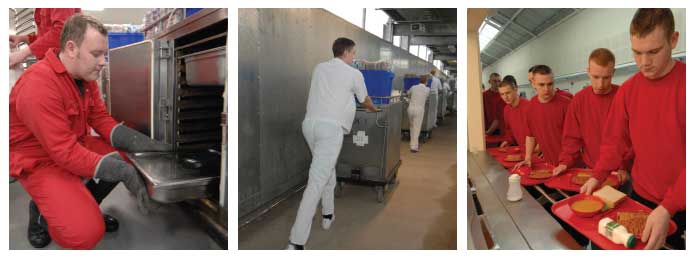
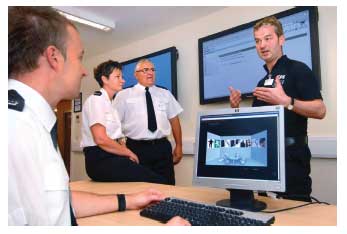
I have been somewhat puzzled by the lack of coordination of effort across the various services in Scotland. Currently, I am concerned that offender management is not integrated with community-based and local services. This issue is important in two respects. Firstly, because effective integration would ensure that every liberated prisoner would re-enter the community with better practical and moral support. Such support, as certain Third Sector schemes have already shown - the 'Routes Out of Prison' scheme for example - would go some way toward reducing the risks of re-offending. Secondly, without being able to track offenders when they are back in the community it is almost impossible to measure the effectiveness of the various programmes and interventions to which they have been exposed in prison. In this respect, when I ask Prison Governors how effective interventions have been in reducing re-offending and in changing a prisoner's behaviour, attitude and response for the better, they are unable to provide any clear evidence of what works. Given the amount of public money spent on the rehabilitation agenda, I find this an unsatisfactory state of affairs.
It is very illuminating to observe a family prison visiting session. One sees the emotion and commitment required to support a family member in prison. It is common for me to see families leaving a prison visit in a state of distress. However, in some prisons visitors are not aware of prison-based Family Contact Officers. In some prisons, visit rooms and waiting rooms are worse than inadequate. For some families the round trip from home to prison can be lengthy, expensive and awkward. It is very difficult to get to prisons such as Glenochil or Shotts from the Borders or the Highlands and Islands on public transport on time, within a reasonable budget and on a regular basis. Yet in many cases, it is the family who hold the key to success in supporting the prisoner through his or her time in custody and successfully back into the community. So there is also much to be done here to improve matters.
Finally, I have gained an impression of an organisation that hides its light under a bushel. Despite areas for improvement and development, the Scottish Prison Service has much of which to be justifiably proud and yet spends much of the time being unnecessarily defensive. The SPS is the custodian of many of Scotland's most vulnerable, most violent and most dangerous people. As I have already made clear, it is my view that the Scottish Prison Service does an essential job soundly and with great care; I challenge them to communicate this in a more positive fashion in Scotland. I shall be interested to see, when I inspect Addiewell in 2010-2011, how this private prison addresses this challenge.
The Inspectorate Team
Throughout this first year I have been supported by a small but experienced and effective team. I have been particularly grateful for the technical advice and support I have received from my Deputy; initially John McCaig who introduced me to the post with great patience and now Kate Donegan, a senior Governor whose breadth of knowledge and experience is vital as we develop our inspection methodology.
We are supported during full inspections by two Inspectors from HMIE who provide description and analysis on education and activities in our prisons and make a significant contribution to the subsequent written report. This educational expertise is exceptionally helpful. So too is the expertise provided by the Social Work Inspection Agency. I am also able to use two Associate Inspectors on loan from the SPS to assist our work. These Inspectors not only provide a high standard of inspecting but also learn much for their own development. In my opinion this method of augmenting the permanent team provides excellent value for money.
Scotland's Prisoners
From my initial impressions, it is obvious that Scotland's prisoners, male, female, young and old do not represent a cross section of Scottish society. The majority are from poor socio-economic backgrounds, often from dysfunctional families and with underlying causes of offending related to misuse of drugs and alcohol, mental ill health and physical and sexual abuse. In most cases, there has also been poor connection during childhood with the education system.
In Dr McLellan's final report he quoted from his first report: " the only way to have better prisons is to have a better Scotland". I now know what he meant. It is very obvious that when I speak to prisoners, there is both a mood of despair as well as a sense of relief. Despair because they feel the circumstances into which they were born ensured for them at least that prison would be an inevitable outcome. Relief because they are, for the period of their sentence, relatively safe from peer and gang pressure. This paints a depressing picture about those postcode areas in Scotland from which the bulk of the prison population is drawn.
The country is paying a heavy price for offending behaviour, both financial and moral. The financial cost can be summed up in the cost of a prisoner place within the SPS which averages almost £32k per annum. This figure does not include capital costs. Worse, the cost of keeping a child in a Secure Unit can be as high as £250k per annum. Securing children, young offenders or prisoners is not a cheap option.
According to Audit Scotland, the Scottish Government is spending £173m directly on drug and alcohol services; the human cost of this is more difficult to establish. An average of 56% of all offenders admitted to Scottish prisons test positive for drugs. So, on cost alone, there must be pause for thought on the best ways to deal with those at risk of offending before they enter the Criminal Justice System.
But there is also a moral cost for us all to bear and that is the waste of potential of those citizens who are not able to contribute constructively to society in general or within their own families in a positive way. In this regard it would seem that prevention must be a better way forward than cure and I will continue to work with the Scottish Government and other agencies to explore how this might be achieved. For example, many ask why offenders have to go to prison to gain access to a well-equipped gym, or to structured and appropriate education or to vocational training? This is where youth, sport and community-based organisations might be able to change behaviours before young people become at risk of offending. I have been impressed by fully integrated schemes that are beginning to make a difference in this area. I hope we can engage productively in this discussion.
I have been surprised that TV Link technology is not being used to a greater extent for appropriate pre-trial appearances. For example in the Cornton Vale Report I recommend much greater use of video conferencing systems to reduce the number of prisoners on remand invariably having to attend court in person; currently women travelling to outlying courts spend long and uncomfortable trips when in most cases the use of video conferencing could potentially be just as satisfactory and substantially less expensive. I am told the use of such technology is still not being embraced.
Separately I have seen how the SPS use video conferencing visits to aid Integrated Case Management case conferences and to assist family contact, particularly for those living in remote areas; these systems work well and I will continue to encourage greater use of them in the future.
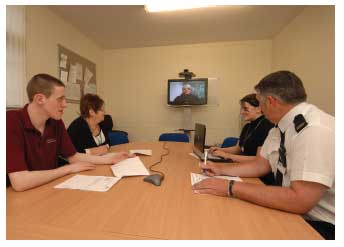
I am also particularly concerned about the plight of female offenders. I have reported in detail on the unsatisfactory conditions and treatment of female prisoners at Cornton Vale.

Female offending is on the increase and that is clearly reflected in the growing numbers at Cornton Vale. Many female offenders suffer from chronic and longstanding mental health problems and a high proportion suffer from drug and alcohol dependence. The chaotic lifestyles, poly drug abuse and dysfunctional family relationships of many of the women, make their management particularly challenging. I have not seen sufficient corporate attention given to this group of offenders.
Areas of special interest
My principal responsibility as Chief Inspector is to examine the treatment of prisoners and the conditions in which they are held. This remains my main focus. As a result of observations from my first two full inspections of Cornton Vale and Perth, the Inspectorate has begun to develop a new approach. This is based on six areas of special interest to me. We will focus on them during inspecting year 2010-2011.
Training and Development of Prison Staff
Staff behaviour, attitudes and competence directly affect prisoners and how they are treated. Staff training therefore has an important impact on the treatment of prisoners. Currently, SPS training is divided into a range of 22 compulsory subjects which require to be refreshed either annually or every three years depending on role. Target completions for these are measured at each prison's tri-annual business review meeting. Separately, there is a range of new recruit, staff development and specialist training which is delivered either at the Scottish Prison Service Training College or arranged locally within prisons. It is my view that training is fundamental to the ethos of a professional organisation, both for specific service delivery requirements but also for developing and 'growing' individuals within it. This is not being adequately achieved at present and we have found substantial training gaps across the board. I will be able to report more substantially next year on the size of this gap and whether it also exists in private prisons.
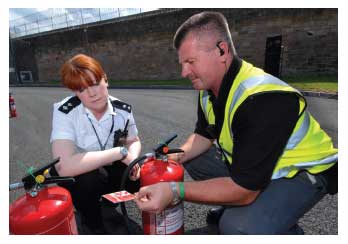
Smuggling of illegal items into prison
I have very real concerns about the smuggling of illicit and unauthorised items into prisons - specifically drugs, personal communication devices and weapons - all of which cause prisons to be less safe. My concerns centre on the volume and nature of the trade and the fact that it enables criminal activity to continue from within the prison. It causes bullying and intimidation to be perpetrated; for substance misuse to continue to the detriment of prisoners' physical and mental health; and for potential operational instability to result. It seems wasteful to spend significant amounts of public money on programmes to address, for example drug addiction, when an average of 17.5% of prisoners on liberation from closed establishments are still testing positive for drugs. Equally concerning is the obvious fact that by its very existence, successful smuggling demonstrates that the prison's security systems have been breached. I will be taking a close interest in the SPS's strategy for, and success in, addressing smuggling activity. I will also take an interest in the ways in which SPS measures levels of illegal drug taking from admission to liberation.
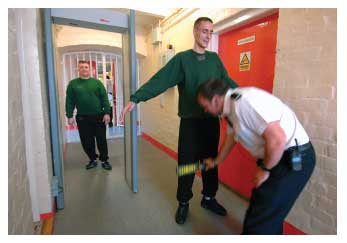
Addictions
The scourge of drug and alcohol abuse is a drain on our nation's resources and a significant underlying cause of much offending behaviour. The SPS faces a huge challenge in dealing with offenders whose addictions have damaged their own lives and those of many others. It is clear, however, that the SPS sees addictions issues in the broadest sense, as a priority for resources and action. The national addictions strategy is aimed at addressing chronic substance misuse among prisoners, and I see considerable efforts being made to ensure its integration and delivery at local level. However, I have to question whether prisoners receiving methadone on prescription should be encouraged more proactively to reduce their dose. I shall be scrutinising this more thoroughly in 2010-2011.
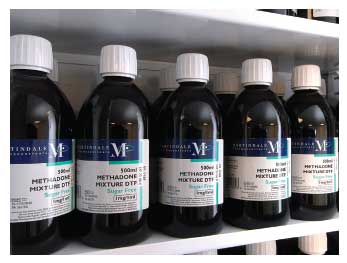
Family Strategy
The treatment of families of prisoners is an important part of the treatment of prisoners themselves. If the family is to be seen as part of the solution to the prisoner's offending behaviour, then prisons need to engage proactively with them from the earliest possible stage. This requires a consistent standard of visit provision and experience. It means that travel to the prison should be as easy as possible (a factor outwith the influence of the prison); that visit times and periods are convenient and easily arranged; that the process of visiting, including the process of being searched, should not be demeaning; and that specific, dedicated prison staff (Family Contact Officers) are appointed, ideally on a full time basis, to liaise with family members.
I would like to see more productive efforts by SPS and other agencies to encourage family involvement in the ICM process.
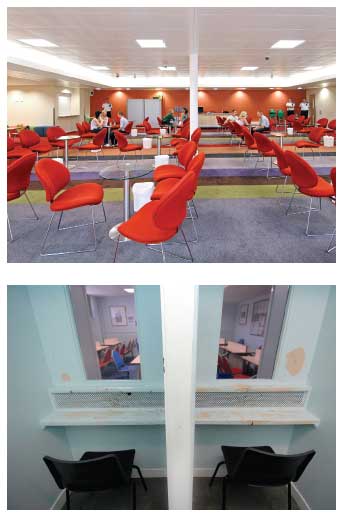
As an integral part of the approach to families, it is my view that at certain prisons, either those prisons which are national facilities or those with poor transport links, Visitor Centres should be an essential requirement. Visitor Centres provide refreshments, a place to wait in decent conditions and an opportunity for families to gather themselves in advance of a visit and to regroup afterwards. The staff at Visitor Centres can provide essential support and advice to families and can signpost additional services as required. With some imagination and commitment, Visitor Centres could be resourced and operated jointly by the SPS, community partners and Third Sector organisations. Variations on this principle work well at Edinburgh and Perth prisons and to a certain extent at Kilmarnock where there is a very small Visitor Centre. I understand, however, that funding is always an issue. My aim, therefore, is to put this issue onto the National agenda, as it will require more than just SPS action to move forward.
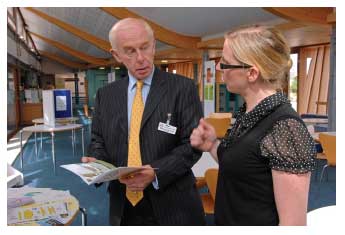
Community Partnerships
Prisons require good links with community-based organisations to be in place if the underlying causes of offending behaviour are to be addressed and prisoners and their families adequately supported in the aim of reducing offending. If Integrated Case Management is to reach its full potential, there have to be clear pathways in place for the delivery of offender services in collaboration with community-based partners. My observations so far reveal an inconsistent picture in terms of tangible outcomes from partnership working. Some prisons and community partners are more proactive than others and while relationships are invariably cordial, it is often difficult to see clear outcomes for integrated offender management.
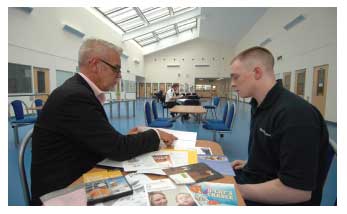
Preparation for Release
Reducing re-offending is a core goal for the SPS. Preparation for the release of prisoners is therefore a critical activity, particularly for those offenders who have been sentenced to long periods for violent or sexual offences. I am concerned to find that much of the guidance for Governors on these important elements of prisoner management is fragmented and piecemeal. For example, there is no published national strategy/policy on prisoner progression and community reintegration. As a result, I am finding a variety of approaches to internal progression and pre-release preparation across prisons and therefore no robust means of evaluating a prison's performance in this area. The absence of a national strategy needs to be addressed.
In terms of preparing prisoners for release, I worry that the availability of programmes designed to reduce re-offending is more limited than I would like. On occasions when I visit or inspect prisons, I see too many prisoners in halls or cells rather than taking part in gainful activity. This imbalance needs to be corrected if attempts to address underlying causes of offending are to be more successful.
Whilst the ICM process is the principle vehicle for managing an offender and each prisoner has a Community Integration Plan prepared prior to release, neither tool can guarantee that the requisite interventions or services identified will actually be delivered to the offender either in custody or on release. In essence, this is the reality of the gap between identified needs and available provision both within prison and in the community. That said, there is a great deal of effort being made within prisons to focus resources in a measured way, in an effort to balance risk and need.
Overview of Inspections 2009-2010
The Inspectorate inspected three prisons in 2009-2010: Greenock, carried out by Dr McLellan and his team and since my arrival, Cornton Vale and Perth. Living conditions in the older halls at Greenock are not good and these will be re-inspected. Perth received a strong and positive report. Cornton Vale received a number of criticisms not least that the basic necessities are not being met. This prison will be re-inspected in February 2011.
The Inspectorate participated in a multi-agency report with the Social Work Inspection Agency and Her Majesty's Inspectorate of Constabulary (Scotland) on the management of offenders who present a high risk of serious harm.
The Challenges Ahead
I hope that Governors and staff in Scottish prisons view inspections as they are intended. That is that they are an opportunity and not a threat. My aim is to be supportive and helpful so that the SPS can continuously improve levels of treatment and conditions whilst becoming more effective in delivering services to help reduce re-offending. The comments that I am able to make in my reports have this goal in mind.
The Inspectorate provides recommendations to allow all prisons, public and private, to focus on areas for improvement and to develop further areas of best practice. In 2010-2011 we will be taking forward the newly developed inspection process, including the areas of special interest I have described, for the inspections of Glenochil, Peterhead and Addiewell prisons. We will also be assisting the Social Work Inspection Agency with their inspection of Prison Based Social Work. Additionally, at the request of the Cabinet Secretary for Justice, we will be carrying out an audit of the processes used within prisons for progressing prisoners to Open Conditions.
2. Summary of Inspections Undertaken
Establishments
HMPGreenock
Full Inspection 6-13 May 2009
Good Practice
The health centre is adjacent to the reception so initial healthcare assessments are conducted in the health centre.
The arrangements for storing and checking prisoners' property in reception.
The admission procedures.
The First Night Centre in Ailsa Hall.
Most high risk of suicide prisoners are managed in the two or three bed units in Ailsa Hall.
Prisoners are able to keep diabetic equipment in their cells.
Recommendations
The conditions for holding prisoners at Oban Sheriff Court should be improved immediately.
The health centre should be made fit for purpose.
The decision to stop giving prisoners going to court their medication should be reviewed.
Summary
Living conditions in Ailsa and Darroch Halls are not good: cells are cold and feel damp, and toilets in cells are only partially enclosed or not enclosed at all. Living conditions in Chrisswell House are good. The food and the arrangements for washing clothes are good. Prisoners receive good access to exercise in the open air if they want it.
The prison actively tries to ensure the safety of prisoners: both from self-harm and harm from other prisoners. The prison is safe and although the SPS anti-bullying strategy is not used, bullying does not appear to be a problem.
Relationships between staff and prisoners are very good.
Prisoners are well treated by escort staff. The conditions in Dumbarton Sheriff Court are very good. The conditions in Greenock Sheriff Court are good. The conditions in Oban Sheriff Court are dreadful.
The visits room is spacious and bright and has a good café and children's play area. Prisoners can receive more than their visits entitlement. All visitors spoken to said that staff were extremely helpful and friendly.
Complaint forms are readily available in the halls and disciplinary procedures are fair and open. The regime in the segregation unit is poor, although the unit is rarely used.
Learning, Skills and Employability provision is good, and educational programmes are effectively promoted. However, prisoners in Ailsa Hall have limited access to activities.
The health centre is not fit for purpose, but care delivery itself is satisfactory. A proactive clinical mental health service is being delivered and there are good links with Act2Care. Prisoners do not receive their daily medications, including methadone, prior to going to court.
There are very good links with community organisations, and the community work placements for prisoners in Chrisswell are excellent. However, the preparation for the release of sex offenders is poor, although risk is monitored well.
HMP & YOI Cornton Vale
21-29 September 2009
Good Practice
The duty manager conducts random property checks in reception at the weekend.
Prisoners are given two new sets of underwear and two new pairs of socks on admission to the establishment.
The induction arrangements.
The Family Contact Officers have their own, dedicated, telephone number.
The arrangements for prisoners to receive their letters by email.
Mandatory Drug Testing Officers are present during the Care Orderly Rooms.
The use of Peer Tutors in education, particularly for specific training initiatives.
The processes for 'in possession' medication spot checks in the house blocks.
The network and training events held by community agencies in the prison.
The information booklet given out at the end of the pre-release course.
Recommendations
Recommendations for SPS Headquarters
Female prisoners should have a focus at SPS Board level, with a view to setting the agenda to the future and ensuring such an agenda is implemented quickly and with purpose.
The SPS should encourage uniformed members of staff to become familiar with a foreign language in order to build up a pool of expertise in each prison.
General Recommendations
The use of the 'back cells' in Ross House should be discontinued immediately and more appropriate accommodation should be used for the most vulnerable women.
The conditions in Peebles House should be improved.
The conditions in Bruce House should be improved.
The conditions in Younger House should be improved.
As a matter of priority alternative systems to access toilets in Bruce and Younger Houses should be installed. In the meantime, all prisoners should be able to access a toilet within a reasonable time.
Outdoor exercise areas should be improved and maintained.
The regime and arrangements for catering should be improved at the weekend.
Arrangements should be put in place which allow women to be held in custody nearer the court at which they are appearing, if significant travel from Cornton Vale is involved or that greater use is made of court video link facilities. In the meantime, it is recommended that women travelling to court are offered the opportunity to shower before travel; are given a proper breakfast prior to travel; receive their methadone dose prior to travel; are allowed reading materials during travel; and have a hot meal on return.
A purpose built First Night Centre should be created.
The internal progression system should be improved and prisoners should not be moved around the prison as often as they are.
The Suicide Risk Management Group should be reinvigorated.
A purpose built visits facility including a visitor centre as a national resource for Cornton Vale should be created.
A purpose built Mother and Baby Unit should be created.
A purpose built unit to hold prisoners out of normal circulation should be created and staff working in this unit should be properly trained to do so.
The range of education, learning and employability programmes available should be broadened.
A purpose built health centre should be created.
Waiting times to see the dentist should be reduced and dental care should be provided to all prisoners on a needs basis.
Very vulnerable women should have proper care plans in place.
Prescribed methadone should be given to prisoners on the day of their liberation.
Prisoners should be assessed for programmes to address offending behaviour, and when they have been assessed they should be provided with the relevant programme.
Summary
The basic necessities are not provided to all prisoners to an adequate standard. The standard of food, bedding, toilets and showers in the older house blocks in particular is unacceptable. The quality of the facilities for exercise in the open air is poor. The conditions in which most of the women live are unacceptable. The fabric of the estate looks and feels run down.
The prison is acutely conscious of safety and has a number of initiatives in place to prevent prisoners harming themselves and others.
Relationships between prisoners and staff are acceptable.
Prisoners are treated well by escort staff. The conditions in Kilmarnock and Glasgow Sheriff Courts are poor.
A number of good initiatives are in place to ensure that contact with families is maintained. The Family Contact Officer arrangements are excellent. However, the visits room is too small, and has few facilities. The distance which some visitors have to travel makes face-to-face contact difficult.
Many prisoners do not know what they are entitled to. Some prisoners do not have confidence in the complaints procedure.
Provision across a number of areas is target and input driven rather than needs and outcome led. This includes education and initiatives to develop skills. The education portfolio is too narrow and although the majority of prisoners have the opportunity to participate, there are not enough places available. The overall balance between activities and being confined in cells is skewed towards the latter.
If a prisoner is unwell she will receive appropriate treatment. However, the health centre is not fit for purpose and there is a long waiting list to see the dentist. Due to recruitment and retention difficulties staff are struggling to deliver a number of services.
There are excellent links with community based organisations to help prisoners reintegrate back into the community. Addictions throughcare is also very good. However, programmes to address offending behaviour have stalled.
HMP Perth
14-20 December 2009
Good Practice
The 72 hour assessment period for prisoners who request protection.
A choice of fruit is available with each evening meal, and prisoners can choose to have vegetables as part of every meal.
The kitchen produces menus in the two most common foreign languages in the prison.
The 'Core Screen Assessment' during induction is carried out in a private interview room.
The arrangements for relaying information to non-English speaking prisoners during induction.
Suicide risk management procedures are tailored to the individual needs of the prisoner.
Families sometimes attend suicide risk management case conferences.
The staff rotation policy and practice.
All escort court staff in Dundee Sheriff Court are first aid trained.
A dedicated telephone number is available for families who need advice or help.
All visits staff are encouraged to engage with families and children.
Innovative use of technology to allow 'virtual visits'.
The service offered by the prison library.
The availability and standard of gym facilities.
The production of an electronic healthcare night report.
The blood borne virus and sexual health clinics.
The doctor and addictions nurse see all prisoners receiving methadone prior to liberation.
The addictions nurses have piloted a process where they see all new short-term prisoners with a substance misuse history on the day of admission.
There are intense one-to-one interventions and cognitive behavioural therapies available when a prisoner is assessed as suitable for this kind of intervention.
Recommendations
Young offenders in Friarton hall should be more gainfully employed.
Friarton hall should be completely refurbished.
All suicide risk assessments during reception in the main prison should be carried out in a private and calm environment.
A more structured approach based on good practice in other prisons should be adopted in the First Night in Custody Centre.
All safer cells should be of the modern design.
The reasons for so many prisoners testing positive for illegal substances on liberation should be explored.
Summary
The basic necessities are met. The three halls in the main prison are very clean and excellent arrangements are in place for exercise; changing bedding; and laundering clothes. The food is very good in Friarton, but the hall is very dirty and in need of refurbishment.
The prison is safe; levels of serious violence are low; there have been no escapes since the last inspection; and the processes in place to prevent self harm are good.
Relationships between prisoners and staff are very good, and prisoners are treated with respect at all times in the main prison. Relationships in Friarton hall do not appear to be as good. Prisoners are very well treated by escort staff. The conditions in Perth Sheriff Court and Dundee Sheriff Court are poor.
Arrangements for maintaining contact with family and friends are very good. The visits room, although temporary, provides a very good visiting experience. A visitors centre, located in the prison car park, offers a good and supportive service to visitors.
The complaints system works well and disciplinary procedures are fair.
There are good opportunities to participate in education and work. The learning centre, library and gym are excellent facilities. The quality of education is high. Young offenders in Friarton hall also have the opportunity to undertake study in the community, although there are not enough of them gainfully employed.
Healthcare facilities are excellent and very well used. Prisoners in Perth have access to the same level of care as people in community. Addictions clinical support and throughcare is provided to a very high standard.
The number of prisoners testing positive for illegal substances on liberation seems high.
The Integrated Case Management and risk management processes work very well. A number of offending behaviour programmes are available to adult prisoners. There are excellent links with community based organisations.
Other Report
Assessing and Managing Offenders who present a High Risk of Serious Harm: A Multi-Agency Thematic Inspection
Background
This report presents the findings of a joint inspection by the Social Work Inspection Agency, Her Majesty's Inspectorate of Prisons and Her Majesty's Inspectorate of Constabulary for Scotland of the management of high risk of serious harm offenders. The inspection team comprised inspectors from each of the three inspectorates, reflecting the integrated approach expected from the agencies with responsibility for managing these offenders. The findings are presented in the cross-cutting areas of risk assessment, risk management, and sharing information and working together effectively.
The report identifies where practice and procedure to minimise and manage risk can become better, and adds to the body of knowledge about the management of high-risk offenders in Scotland.
Recommendations
Recommendations for Scottish Ministers
1. That Scottish Ministers amend the MAPPA guidance quickly to ensure that MAPPA meetings always consider a full analysis of risk of serious harm to support defensible decision-making.
2. That Scottish Ministers publish national standards and guidelines for risk assessment practice. These should make clear that fully assessing risk of serious harm is necessary for both sex offenders and serious violent offenders.
3. That Scottish Ministers ensure that there is succinct, plain and unambiguous practical guidance for managers and practitioners on the MAPPA process.
4. That Scottish Ministers ensure that when prisoners who present a high risk of serious harm have home leave or an external work placement, there is an effective and multi-agency risk management plan for the period that the offender is on these activities.
5. That Scottish Ministers ensure that members of the judiciary considering risk assessments prepared by police and social work are familiar with the policy and procedures in place for such risk assessments and the strengths and limitations of the various risk assessment tools in use.
6. That Scottish Ministers coordinate action to ensure that prisons receive information timeously when an offender commences a sentence for a serious violent or sex offence.
7. That Scottish Ministers promote the effective integration of health services in MAPPA, in order that the information they hold and their expertise can contribute better to improved offender management.
8. That Scottish Ministers undertake a national review of joint and integrated working practices in place between police, social work services and other relevant agencies, including co-located units, in order to identify and disseminate good practice.
Recommendations for Scottish Ministers and agencies
9. That Scottish Ministers and responsible MAPPA authorities reassess whether it is necessary for police to carry out a full SA07 assessment with every offender assessed as low risk of reconviction using RM2000 and managed at MAPPA level 1.
10. That Scottish Ministers and agencies develop and implement formal protocols for information sharing between agencies about serious violent offenders.
11. That Scottish Ministers, the national Policing Improvement Agency ( NPIA) and responsible authorities urgently address the reasons underlying the poor use of the ViSOR database by agencies other than police.
12. That Chief Social Work Officers ensure that social workers preparing home background reports interview the prisoner and visit the prospective release address. Reports must always specifically address risk issues.
13. That Chief Social Work Officers ensure that every sex offender and serious violent offender on supervision has a full and current risk of harm assessment. This must be available to all those tasked with the responsibility for risk management.
14. That Chief Constables, the Scottish Prison Service, and Chief Social Work Officers ensure that sex offenders and serious violent offenders subject to supervision have an effective risk management plan tailored to their risk and needs.
15. That the Scottish Prison Service connect the operation of the Risk Management Groups directly to the ICM framework. This would eliminate duplication and increase the coherence of the system.
16. That the Scottish Prison Service develop a strategy for the more effective engagement of those prisoners who refuse to participate in a change programme, and ensure that ICM annual case conferences occur for every offender at the correct intervals.
17. That Chief Constables, the Scottish Prison Service, and Chief Social Work Officers arrange appropriate training for their staff involved in MAPPA to ensure that they understand and consistently meet the needs of the Parole Board.
18. That Chief Constables, the Scottish Prison Service, and Chief Social Work Officers formally select employees dealing with high-risk offenders, and ensure they receive an appropriate range of support, training and professional advice, including training on giving evidence in court.
19. That MAPPA 'responsible authorities' establish local strategic boards to oversee the performance management and quality of local MAPPA operations and plan for the future improvement and development of the system.
Summary
The findings of this inspection show a mixed picture of how agencies manage offenders who pose a risk of serious harm, with variations across the country in risk assessment and risk management practice. Aspects of information sharing required significant improvement, for instance there were serious problems in social work and prisons access to the electronic Violent and Sex Offender Register ( ViSOR) database, which therefore had unfulfilled potential to improve information sharing between agencies. There was also evidence that when a high-risk offender came into custody, information about risk often did not reach the receiving prison.
Community-based social work planning for sex offenders and violent offenders was often not good enough. One-third of the social work plans for sex offenders reviewed lacked sufficient quality, and plans for two-thirds of serious violent offenders did not have any focus on risk management. Even when plans provided for home and unannounced visits, often these did not occur in practice.
The Multi-Agency Public Protection Arrangements ( MAPPA) had improved the management of sex offender risk, and the Integrated Case Management ( ICM) approach in prisons had improved the multidisciplinary management of prisoners through their sentence and up to the point of release. Agencies worked in a purposeful manner to protect the public from the risk posed by sex offenders, but the management of serious violent offenders was significantly less encouraging.
Health services in prisons could have contributed better to risk management planning during the custodial term, and in linking with community health colleagues at the time of release. In the community, health professionals involvement in attending and informing MAPPA meetings was very inconsistent, and generally at an unsatisfactory level.
Agencies were using a range of risk assessment tools. Whilst many practitioners said these helped to structure their assessments of risk of reconviction, many were also unclear about the critical importance of also assessing the risk of serious harm. Many police officers considered that they were carrying out unnecessarily detailed risk of reconviction assessments on offenders already screened as presenting a low risk of reconviction.
3. Review of the Prison Inspectorate's Year 2009-2010
Inspections and Other Reports
Inspections for the year were completed as follows.
Full Inspections
|
HMP Greenock |
6-13 May 2009 |
|
HMP & YOI Cornton Vale |
21-29 September 2009 |
|
HMP Perth |
14-20 December 2009 |
Other Report
|
Assessing and Managing Offenders who present a High risk of Serious harm: |
2009 |
Submission to the Scottish Parliament
The 2008-2009 Annual Report was laid before the Scottish Parliament on 11 June 2009.
Staff
|
March 2010 |
April 2009 |
|||
|
HM Chief Inspector |
Brigadier Hugh Monro |
(F/T) |
Dr Andrew McLellan |
(F/T) |
|
Deputy Chief Inspector |
Kate Donegan |
(F/T) |
John T McCaig |
(F/T) |
|
Assistant Chief Inspector |
Dr David McAllister |
(F/T) |
Dr David McAllister |
(F/T) |
|
Inspector |
Mick Armstrong |
(F/T) |
Karen Norrie |
(F/T) |
|
Personal Secretary |
Janet Reid |
(F/T) |
Janet Reid |
(F/T) |
A list of Specialist and Associate Inspectors for the year is provided below.
HMP Greenock
|
Peter Connelly |
Education Adviser |
|
Iain Lowson |
Education Adviser |
|
Social Work Inspection Agency |
Social Work Adviser |
HMP & YOI Cornton Vale
|
Karen Norrie |
Associate Inspector |
|
John Moffat |
Associate Inspector |
|
Karen Corbett |
Education Adviser |
|
John Bowditch |
Education Adviser |
HMP Perth
|
Karen Norrie |
Associate Inspector |
|
Nicol Welsh |
Associate Inspector |
|
Peter Connelly |
Education Adviser |
|
Andrew Brawley |
Education Adviser |
|
John T McCaig |
Consultant |
Finance
The Inspectorate's budget for 2009-2010 was £345k.
Communications
Recent reports can be found on our website ( www.scotland.gov.uk/hmip).
Email: hugh.monro@scotland.gsi.gov.uk.
